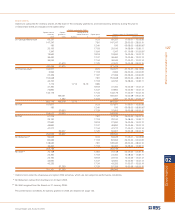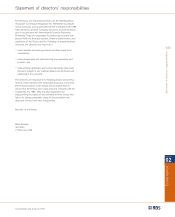RBS 2005 Annual Report Download - page 124
Download and view the complete annual report
Please find page 124 of the 2005 RBS annual report below. You can navigate through the pages in the report by either clicking on the pages listed below, or by using the keyword search tool below to find specific information within the annual report.
122
Directors’ remuneration report
Directors’ remuneration report continued
The RBS Fund is a non-contributory defined benefit fund which
provides pensions and other benefits within Inland Revenue
limits. Certain directors receive additional pension and life
assurance benefits in excess of Inland Revenue limits. Details
of pension arrangements of directors are shown on page 129.
From April 2006, new tax legislation will apply to UK pensions;
in particular any pension in excess of the Lifetime Allowance
will be subject to additional taxation. The Group will allow
directors and employees whose benefits do, or are likely to
exceed the Lifetime Allowance to opt-out of future tax-
approved pension provision. In such cases the Group will pay
the individual a salary supplement in lieu of pension provision.
The Group will not meet the cost of any additional tax that
individuals may incur as a result of their benefits exceeding the
new Lifetime or Annual Allowances.
Executive directors are eligible to receive a choice of various
employee benefits or a cash equivalent, on a similar basis to
other employees. In addition, as employees, executive
directors are eligible also to participate in Sharesave, Buy As
You Earn and the Group profit sharing scheme, which currently
pays up to 10 per cent of salaries, depending on the Group’s
performance. These schemes are not subject to performance
conditions since they are operated on an all-employee basis.
Executive directors also receive death-in-service benefits.
Short-term annual incentives
As part of the overall review of the executive remuneration
package referred to above, short term incentive levels were
considered and the Remuneration Committee agreed to increase
annual incentive potentials to reflect market practice and the
setting of stretching new targets. As a result, from 2006
individual UK-based executive directors will normally have a
maximum annual incentive potential of between 160% and
200% of salary. These will typically focus from year to year on
the delivery of a combination of appropriate Group and
individual financial and operational targets approved by the
Remuneration Committee.
For the Group Chief Executive, the annual incentive is primarily
based on specific Group financial performance measures such
as operating profit, earnings per share growth and return on equity.
The remainder of the Group Chief Executive’s annual incentive
is based on a range of non-financial measures which may
include measures relating to shareholders, customers and staff.
For the other executive directors a proportion of the annual
incentive is based on Group financial performance and a
proportion on division financial performance. The remainder of
each individual’s annual incentive opportunity is dependent on
achievement of a range of non-financial measures, specific
objectives and key result areas. Divisional performance
includes measures such as operating income, costs, bad
debts or operating profit. Non-financial measures include
customer measures (e.g. customer numbers, customer
satisfaction), staff measures (e.g. employee engagement) and
efficiency and change objectives.
For exceptional performance, as measured by the achievement
of significant objectives, executive directors may be awarded
incentive payments of up to 200% of salary, or 250% of salary,
in the case of the Group Chief Executive. This discretion to
pay additional bonuses for exceptional performance was last
used in 2002 to recognise the successful integration of Natwest.
Long-term incentives
The company provides long-term incentives in the form of share
options and share or share equivalent awards. Their objective
is to encourage the creation of value over the long-term and to
align the rewards of the executive directors with the returns to
shareholders.
The Group’s policy is to encourage executives to hold shares
and retain vested long-term incentives. This policy has
successfully built high levels of shareholdings and equity
participation amongst executives. A table showing directors’
interests in shares and the estimated value of the shares and
vested long term incentives held by executives is shown on
page 130. In light of the already high levels of share price
exposure, the Remuneration Committee is not proposing to
introduce mandatory or guideline shareholding requirements
for executives at this time.
Medium-term performance plan
The medium-term performance plan (“MPP”) was approved by
shareholders in April 2001. Each executive director is eligible
for an annual award under the plan in the form of share or
share equivalent awards. Whilst the rules of the plan allow
awards over shares worth up to one and a half times earnings,
the Remuneration Committee has adopted a policy of granting
awards based on a multiple of salary. Normally awards are
made at one times salary to executive directors, with one and a
half times salary being granted in the case of the Group Chief
Executive. No changes will be made to this policy without prior
consultation with shareholders. All awards under the plan are
subject to three-year performance targets.
The award in 2005 is subject to two performance measures.
First, the annual growth in the company’s earnings per share
(“EPS”) must exceed the annualised growth of the Retail Prices
Index (”RPI”) plus three per cent. If this condition is satisfied,
the company’s total shareholder return (“TSR”) is compared
with the TSR of a comparator group of companies. The
companies are Aviva plc; Banco Santander Central Hispano S.A.
(“BSCH”); Barclays PLC; Citigroup inc.; HBOS plc;
HSBC Holdings PLC; Legal & General Group plc; Lloyds TSB
Group plc; Prudential plc and Standard Chartered PLC. Awards
made under the plan will not vest if the company’s TSR is below
the median of the comparator group. Achievement of the EPS
target and median TSR performance against the comparator
companies will result in vesting of 25% of the award, increasing
to 200% if the company achieves a TSR ranking at first position
in the comparator group and exceeds the TSR of the second
placed comparator company by at least 34%.
During 2005, the Remuneration Committee reviewed all
elements of the plan including the performance conditions, the
vesting schedule and the comparator group. As a result, it is
intended that for awards made from 2006, 50% of the award
will vest on a relative TSR measure and 50% will vest on growth
in adjusted EPS over the three year performance period.
























